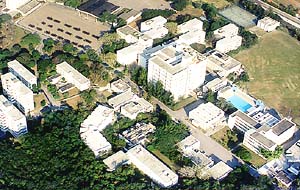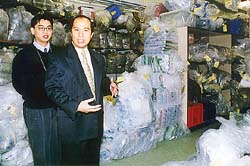



















| Police Training School | |
|
ON Saturday 28 February 1998, the Police
Training School celebrated 50 years of excellence in police training on the school's present site
with CP Hui Ki-on officiating at ceremony, followed by the unveiling of a plaque in the garden
outside the old teaching block. Although the recent anniversary of the Police Training School
represents the 50 years that it has been located at Wong Chuk Hang in Aberdeen, a school for
Hong Kong police officers was started long before that - on 1 October 1869, to be exact.
Back then, Master in Charge Edward Willcocks ran an evening school for European, Indian and Chinese members of the Police Force and the Gaol Staff. Attendance was voluntary, but by 1872 became compulsory for all members of the Force stationed in Central District, or within easy walking distance to Central Barracks where the School was held. |
 Fifty years on, the importance of the school to the Force and the community continues to grow, with both recruits and serving officers ensured the highest possible quality training |
|
In 1909, under the charge of Arthur Grant, the Police School's roster boasted an attendence of "10 Europeans, 169 Indians and 195 Chinese." On 1 March 1920, a new Police Training School was opened in Central Police Station. During its first ten months of operation the school trained 326 officers. In February 1923, the Police Training School was removed from Central Police Station to Harbour View, but by 1928, it moved again, this time to Kowloon-side at the junction of Prince Edward Road and Nathan Road. The Police Training School remained there until the Japanese invasion during World War II. After the return of British rule, a temporary training school was established in Kennedy Road. Staffed by ex-Royal Air Force officers, it churned out the urgently needed nucleus of a police force. By 1946, the School had moved to St. Stephen's Primary School in Stanley and, in 1947, to the Chinese Young Men's Christian Association in Waterloo Road. A permanent site was secured at Aberdeen for the new School and a plan prepared in 1946 for the creation of a first-class training school which the Force badly needed. The Police Training School moved into its present home at Wong Chuk Hang in February 1948. The accommodation comprised a number of pre-war rice godowns spread across the 18-hectare site (which during the War had been used as Japanese military barracks before becoming a small refugee camp). Other than the main parade square, the Police Training School has altered almost beyond recognition. The square is now bounded by the Band Block, opened in 1983, the six storey New Teaching Block which was opened in January 1989, and by sports fields where paddy fields previously existed. The first regular Police Band was formed when W B Foster, who had been Band Master of the Royal East Kent Regiment since 1930, took up his appointment as Music Director in 1950, when the Hong Kong Police numbered 4,164. Staff and students of the Police Training School now number about a quarter of the size of the Police Force in 1948 and double the Police Force of 1869, when there were only 638 constables. Over the years the Police Training School facilities have been developed and now provide properly equipped teaching, sports, accommodation and leisure facilities for recruit police constables and probationary inspectors who live at the school during their initial training and for officers attending in-service courses who travel to and from the school daily. The school can accommodate 1,200 officers at any one time. Apart from residential accommodation there are messes, a canteen, a laundry, a dental clinic, a doctors' surgery and a mini bank. The school's 470 full time staff provide and administer over 30 types of training courses for police officers. Each of the 65 classrooms has permanent audio-visual facilities including whiteboards, an overhead projector, closed circuit TV and computerised presentation equipment. Ditto the 264-seat auditorium. Practice in police skills takes place in the School's Mock Report Room and Mock Court, while incidents "on-the-beat" can be simulated on any of the school's roads. Officers study in the library and reading room, which also has an Internet facility. A TV studio complex and the Training Aids Section produce instructional videos for all forms of training. The Examinations Section uses computers to prepare examination papers and trainees sit in any of four large examination halls. The school's eight-lane, heated swimming pool is for swimming, lifesaving and instruction in cardio-pulmonary resuscitation. Two fully equipped gymnasia, a sports field, tennis and badminton courts, an all weather jogging track and a fitness trail are in use daily for physical fitness and self defence training. Firearms training begins on entry to the school and continues throughout an officer's careers in two outdoor ranges and an indoor range which feature electronically controlled and programmed targets. Two mini ranges and three firearm training simulators are equipped with sophisticated interactive video systems to allow practice not only in marksmanship but also in decision making and response when faced with simulated life-like scenarios. The school also provides five regional continuation training centres which police constables attend during their first two years of service after passing out. A mock court is used to develop officers' knowledge and skills for giving evidence. The responsibility for providing outdoor personal development courses for the Force, previously undertaken by the Police Adventure Training Unit, is now undertaken by a non-Government agency - the Outward Bound School. In 1996/97, 137 probationary inspectors and 740 recruit constables completed their recruit training, 2,793 serving officers attended various continuation, promotion and specialist training courses. | |
| The Police Drugs Disposal Unit | |
 Search and destroy. CSP Narcotics Bureau Koo Sii-hong (front) with NB Detective IP Ke Ka-keung in one of Police Headquarters' strong rooms |
LAST year the Police Drugs Disposal Unit
destroyed 28 kilograms of opium, 444 kilograms of heroin, 2,885 kilograms of cannabis, 27
kilograms of cannabis resin, 16 kilograms of cocaine, 119 kilograms of ice and a small amount
of psychotropic substances.
These were drugs seized during operations and used as evidence/exhibits in court against those from whom they were confiscated. The Narcotics Bureau maintains four strong rooms in which to house its drug exhibits and drug paraphernalia while pending court trials. One item of note is an opium pipe manufactured in 1868 and kept for historical value and training purposes. |
|
Three of these impregnable strong rooms are at Police Headquarters and one is at Central Police Station where 600 kilograms of heroin, 2,400 kilograms of cannabis and 50,000 tablets of psychotropic substances including MDMA and Part I Poisons are kept. Valued at about $4 billion, these exhibits are stored in a temperature-controlled environment. Some evidence bags contain illicit drugs that date back to 1979. Upon completion of a court case involving the drugs in question, and following a six-week's legal appeal period - and when the drug evidence is no longer necessary - it is destroyed. Every month the Police Drugs Disposal Unit handles and destroys about 1,500 exhibit bags containing illegal drugs of completed cases involving narcotics. Disposal is strictly controlled. ACP Crime appoints a board comprising a police superintendent and a chief inspector for the procedure. Before the drugs are destroyed, Government chemists conduct random re-analysis checks on the bags to confirm contents match labels. The SP and CIP then check the drug exhibits to be destroyed against a list entered in the Dangerous Drugs Register. (An officer from the Audit Department may also be present to act as an independent witness). The drugs are then put into paper drums and under security escort are transported to a chemical waste treatment centre where they are destroyed. Drug manufacturing paraphernalia is first decontaminated then buried at specified landfill sites. | |
NARCOTICS Bureau Chief Superintendent Koo Sii-hong said the number of drug abusers in Hong Kong in 1997 dropped 11.5 per cent when compared with the same period in 1996. The number of drug abusers under the age of 21 also fell. CSP Koo attributed the fall to joint efforts and co-operation between law enforcement, legislation, preventative education, publicity, treatment and rehabilitation. Heroin remains the predominant drug of abuse, police seized 35 per cent less than in 1996 - 202 kilograms. "Hong Kong has ceased to be a transit point for the illicit drug trade," said CSP Koo. "Heroin originating from the Golden Triangle is transported via Burma and Laos into Yunnan, Guangxi to Guangdong Province." Meanwhile, the increasing use of the dangerous drug known as ice has become a growing concern for the Narcotics Bureau. Said CSP Koo: "World-wide ice has become the fashionable drug of youths who frequent discos. They are misled by the myth of a long-lasting 'high' and that it enables takers to stay awake all night." CSP Koo said police are increasing their efforts against ice and according high priority to tracking down syndicates trafficking in it. Hong Kong Police seized 73.6 kilograms of ice in 1997 as compared to 46.8 kilograms in 1996. Criminals who traffic over 600 grams of ice can expected to face 18 years upwards if convicted. Also, amendments to the Dangerous Drugs Ordinance provide for heavier sentencing for adults who exploit young people into drug trafficking activities. The Narcotics Bureau continues to maintain close liaison with overseas counterparts. In fact, Hong Kong drug trafficker to Canada under a post - handover agreement between the HKSAR Government and Canada. This first extradiction under the new Fugitive Offenders Ordinance, was also the first since the change of sovereignty, exemplifying continued co-operation between Hong Kong Police and overseas agencies. |

![]()
